There are a lot of factors in choosing the right cabinet door hinges. The type of cabinet and door being at the top of the list. Followed closely by the type, style, and function of the cabinet hinge. With as many options as there are available, there’s surely a hinge that will work for every possible cabinet door scenario you could imagine.
Types of Cabinets
One thing to consider when selecting cabinet hardware is the type of cabinet you have.There are two types. Cabinets that are framed with a faceframe and those that are not. Cabinets without faceframes are, not surprisingly, called “frameless cabinets”.
Face-frames are attached to the front of cabinets. Faceframes are generally 1×2 material so 3/4″ thick by 1 1/2″ wide. Cabinet sides are almost always 3/4″ or 1/2″ thick so the faceframe covers the front edge of the cabinet and overhangs the cabinet opening.
Frameless cabinets simply do not have a faceframe. The front edge of the cabinet box will have an edge treatment to cover the cabinet material. Frameless cabinets are also called European style cabinets.
Types of Door Installations
Both frameless and faceframe cabinets can have inset and overlay door installations. The position of the door when closed is the determining factor.
- If a door closes inside the cabinet opening, it is inset.
- Generally, when an inset door is closed, it sits flush with the front of the cabinet (or faceframe).
- If a cabinet door rests on the front of the cabinet (or faceframe) it is called an overlay door.
- Full overlay doors cover the full front edge of the cabinet.
- Partial overlay doors cover just a a portion of the cabinet front.
Overlay Doors
The overlay of a door is determined by how much of the cabinet front or faceframe the door covers when it is closed.
- Full overlay covers everything. So you don’t see any of the cabinet box or faceframe when the door is closed.
- Partial overlay doors leave a portion of the cabinet box or faceframe showing.
- The amount of cabinet showing on partial overlay doors is determined by the hinge you choose.
With the wide array of hinges available, you can make your door overlay anywhere from 1/4″ to over 1 1/2″ of your cabinet front material
Overlay doors are easiest to install because they don’t have to be perfectly sized and fitted. Additionally, they are more forgiving if your cabinet door opening is not perfectly square.
Inset Doors
Inset doors sit inside your cabinet opening, usually flush with the front edge.
There is a great deal of fiddle factor that goes into installing inset doors. Your cabinet door must be perfectly sized to fit inside your cabinet opening.
Inset doors are generally sized 1/8″ to 1/4″ smaller (in height and width) than the cabinet opening. This extra space is called a reveal. Getting that reveal perfectly uniform on all sides can be tedious. 1/8″ reveal on all sides is good. If you can get an even 1/16″ reveal you’ve mastered the inset door!
Choosing Hinges
When purchasing hinges, you have a lot of things to consider. In addition to the type of cabinet (faceframe or frameless), and the door overlay, you have lots of different styles of hinges to choose from!
- Concealed hinges – not visible from the outside of the cabinet when the door is closed. These are often called European hinges.
- Semi Concealed hinges – show a portion of the hinge while the rest is concealed inside the cabinet.
- Wrap around hinges – a portion of the hinge is bent to wrap around the door.
- Non-mortise hinges – are surface mounted.
Concealed hinges can be mounted on the surface of the door or a pressed into a “cup” that is drilled into the door. These are often called “cup hinges”. The cup diameter is generally 35mm but that can vary as can the drill depth required to accept the hinge. Most concealed hinges have built in adjustability so you can slightly change the position of the door without relocating the hinge.
Exposed hinges are most often used when replacing hardware on old kitchen cabinet doors. Most don’t have the adjustability that concealed hinges have.
When installing hinges on new doors, I always try to buy hinges that have the most built-in adjustability possible. Not much sucks more than drilling multiple holes in your cabinet sides in order to reposition your door slightly.
With that in mind, let’s break down hinges by cabinet style.
Faceframe Hinges
Deciding between concealed or exposed hinges is a matter of functionality as much as it is a style choice. Exposed hinges add a decorative element to cabinet doors though you loose the adjustability allowed by modern concealed hinges.
This hinge is a self-closing concealed hinge for face-frame cabinets that mounts on the surface. No drilling required. These are designed for use on materials from 5/8″ to 3/4″ thick and allow overlays of 1/2″ to 5/8″ (depending on door thickness).
These hinges are compact and have a soft-close feature. They have 3 way adjustability and come in overlays that range rom 3/8 to 1 3/8″. 35mm cup diameter with 110 degree opening.
A lot of older cabinets have surface mounted overlay hinges. These have no built in adjustability.
Another 3 way adjustability hinge for face frame applications. This is for inset doors. These are not soft close hinges.
Face-frame cabinet hinge that requires no mortising to install. Screw right on to the door and cabinet. Meant for doors that are 3/4″ thick. (Which most doors are.)
Frameless Cabinet Door Hinges
Sometimes hinges can be used for either faceframe or frameless cabinets. Make sure you read all the specifications on the hinges to ensure you’re getting what will work for you.
- These overlay hinges swing the door completely around to the exterior side of the cabinet wall. They’re great for cabinets with slide out shelves.
- This invisible spring hinge is surface mounted and can be used for inset, or overlay doors on frameless cabinets.
This is the kind of hinge I probably use the for frameless cabinets. (When I build a cabinet with a faceframes but there is no lip on my faceframe — this is also what I use.)
Cup Hinge Drilling Jigs
When using cup hinges, make sure you have the right size bit for the cup hinge you bought. The Jig It from Rockler is one of less expensive cup hinge drilling jigs. It helps keeps the drill straight while you drill cup holes. And the stop collar ensures you drill to the correct depth. This jig is about $140.
There are a lot more hinge choices that what I’ve included in this post. It would be impossible to list every single option available. Since new innovations are being made all the time, the list would have to keep growing endlessly.
Hopefully now you have a good understanding of the different types of doors, and overlays. And with that knowledge you should be able to find exactly the type of hinge that you want to use in your next cabinet door project.
Get my Cabinet Building 101 eBook. All the information in one place that you can download and keep on hand!
$9.99Add to cart

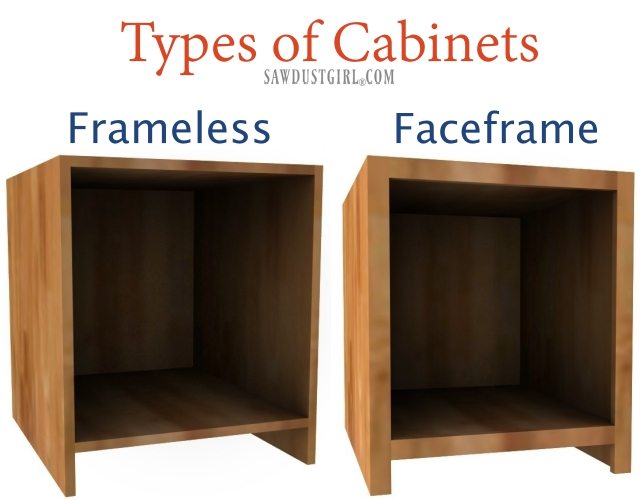
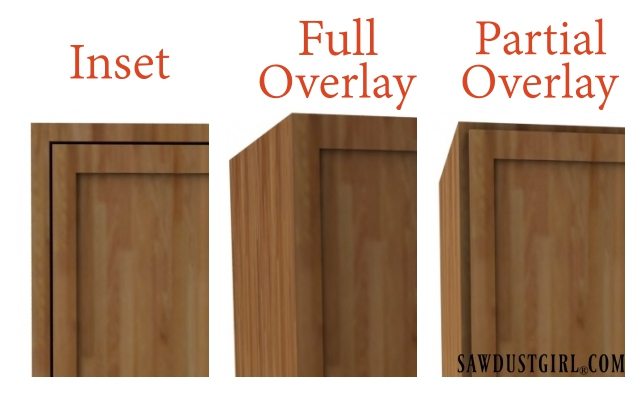
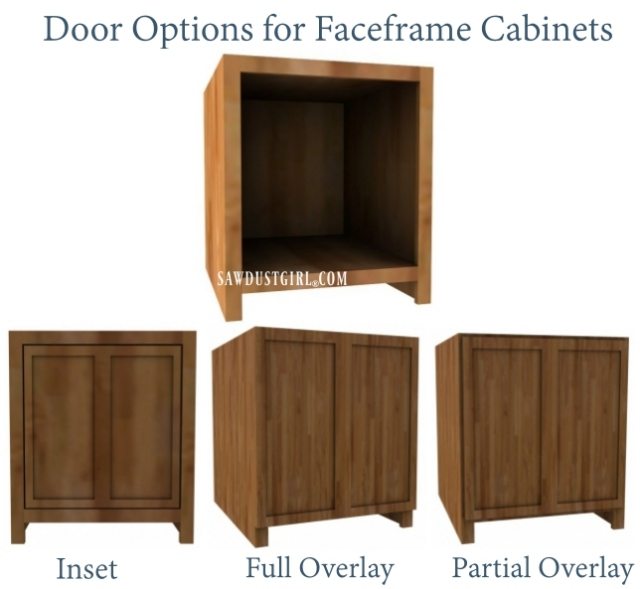

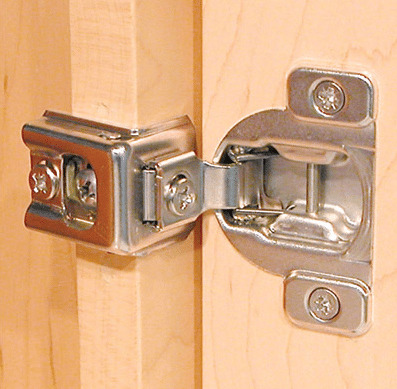
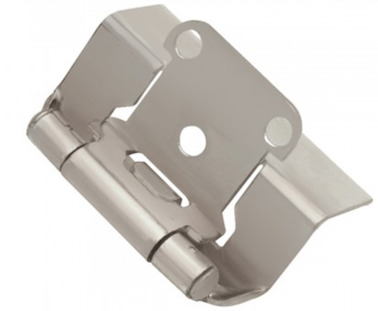

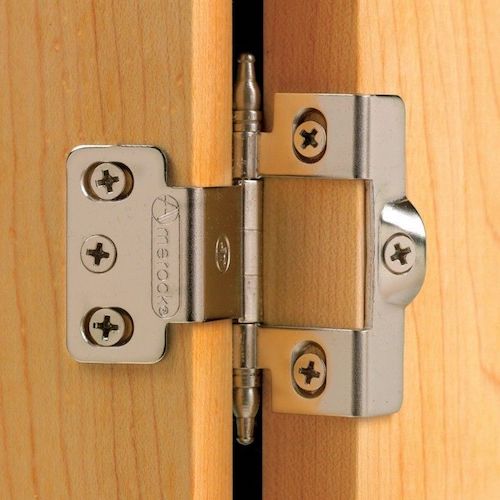
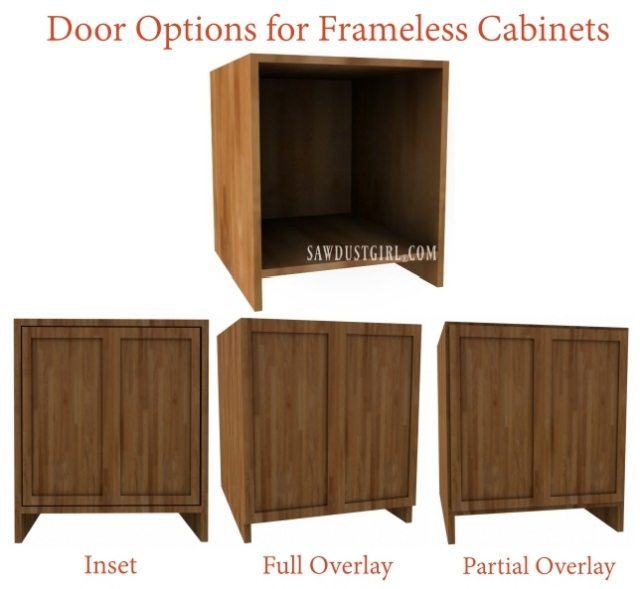
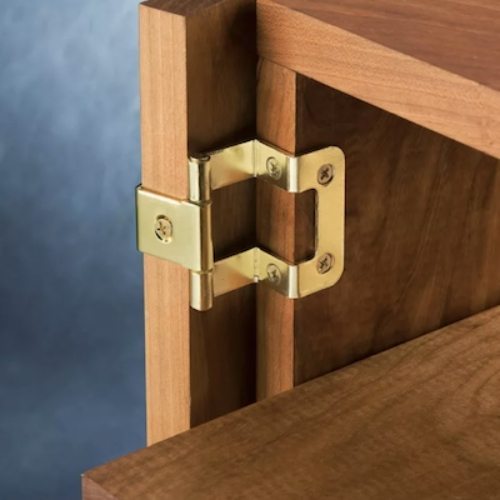
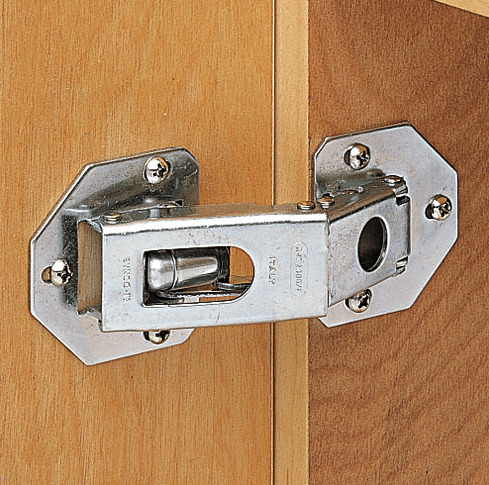
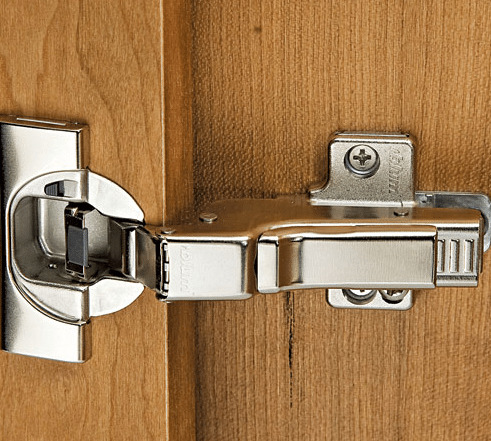
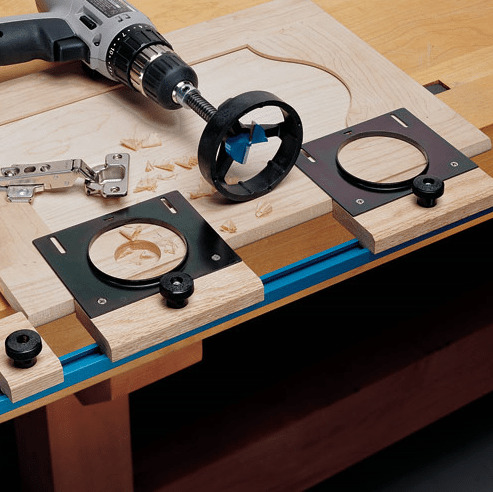

Nancy Williams says
This is post is great! I have the cheap overlay hinges on all my kitchen and bathroom cabinets and would love to replace them with the Blum Frame Hinges if the overlay is big enough. Have you ever retrofitted existing cabinets with them?
Nancy
Sandra says
I have not but there is no reason why you couldn’t.
dana says
but wouldn’t the holes from the original overlay hinges show? I have stained maple cabinets and would love to get rid of the overly hinges but I have two problems. the holes will show, and also, the doors are smaller than what is typical for hidden hinges. All the kitchen cabinetry that I have seen with hidden hinges have cabinet doors that literally touch. inotherwords, they completely cover the cabinet. any suggestions? should I replace the doors? would I save money doing that?
Sarah says
Okay, I haven’t even finished reading this post, but I just have to comment. First of all, I think you are awesome. I have been wanting all kinds of things done to my house, and my husband is pretty capable, but very busy, and far less interested in house things than I am. I just look at the things you do, and I think how I can certainly learn to tackle more of the things that I want to. Second, a post like this is so helpful. I know it takes time to write and I just appreciate the education so much. So, thank you so much for being awesome, and also giving awesome-ness lessons… 🙂
Sandra says
Thank you Sarah. That was really sweet and heck yes, you certainly can tackle more things on your own. Go for it!
kristin says
You are so smart! I have no plans on doing any of this but if I did it would be an overlay door with your 3 way adjustable hinge. Sounds like a great starter door. I love your brilliance Sandra–you inform so many! I know–years of trial and error got you here! Boy, we are glad you’re here. Love your posts and new series with homeowners.
Sandra says
Thanks Kristin!
Cathy Michels says
Thank you Sandra. I have some bathroom cabinets I need to build and have been trying to decide what type of hinges I should use. I will definitely be ordering one of those Rockler jigs! Jigs like that remove my fear of failure and get the project moving forward! I agree with the comments above – you are awesome! 🙂
Sandra says
I’ve been using that jig for like 8 years and I love it. I hope you do too.
Dean says
One thing about those Blum overlay hinges – I think there are different types depending on how much your doors overlay the face frame. You might have a 3/8″ overlay, a 1/2″ overlay, or even an overlay of more than an inch. You need to size your door with one of these overlay dimensions in mind – design and buy accordingly.
Sandra says
Yep. All overlay hinges have different overlays to choose from. (Which is why I suggest selecting and purchasing your hinges before you build your door.) European hinges generally have “full, half or adjustable” and Faceframe overlay hinges have specific partial Inch measurements.
Stephanie says
I have a hutch for dishes that has one broken hinge. There are no identifiable marks/name on the hinge. My hubby has searched local specialty hardware stores and on-line and i’ve searched as well come up with no match. How do I find a replacement or what are my options now?
Lori says
Sandra, I’m so glad that I came across your blog! You’ve given so much great information that I can use every day in my job doing kitchen cabinet sales. And then there’s the whole DIY part for me personally! I’m really hoping that you can answer my question, though. I have a customer who is refacing her cabinets. She has frameless cabinets and used to have exposed hinges. She wanted concealed hinges so we had the hinge holes drilled 1″ (center) from the edge. She has her new doors but when she hangs them, there’s a 1/4″ gap between the door and center stile, even after adjusting them. We were using full overlay hinges. Can you advise which type of overlay hinge to use and how to rectify the gap? Thanks so much!
Peter O says
Sandra,
Good overview of a complicated array of product & fitting styles.
I would like you to please comment on a different aspect:
1) Just about all kitchen cupboard hinges I see go rusty after a few years, say 5 to 10. They remain fit for purpose but look terrible. Nickel plated steel plainly does not cut it! Is there any solution?
2) I also note that it does not take long before doors start to sag & the gaps become irregular. Not hard to fix just lie on your back, take all doors off, then tighten everything & replace – then take a cold shower you will need it! It seems the cup sections remain well fixed but the fixing plates on the inside of the cupboard sides just work loose. This ought not to happen but it does & with all the concealed overlay hinges I have seen. Is there an answer? I suspect the hinges are under rated, 2 hinges for doors that typically are nearly 10Lbs may be the reason. Can you please comment.
Janice says
I have the exact hinge you mentioned under the caption “Then there are Overlay Hinges where you can see part of the hinge as well.” My problem is that on the 3 sets of doors we have that have no center stile, the doors are pushed too far toward center, therefore not enough space to close properly. Any suggestions other than taking down the doors and planing them? Hate that option on already completely finished doors. Great informative post.
Carissa says
Sandra,
Which hinges would I need to use if I wanted to replace my partial overlay cabinet doors with full overlay ones without removing the face frames?
Sandra says
Well you couldn’t simply change the hinges to go from partial to full overlay. If you move the doors over more, to create full overlay, you’d have a gap in the center where the doors meet. You’d have to get new doors.
Mariele says
Excellent post! I already knew about the different options, but it’s so nice to see it all compiled in one place. 🙂 Very handy! I love the look (or rather, lack of) of concealed hinges… but roughly $10 a pair makes me cringe. If I’ve got about 20 doors, I’m looking at $200–for HINGES! The visible hinges run about $3, for $60 total. 🙁 Hmm… debating.
Sandra says
Thanks so much. Isn’t it crazy how expensive hardware can be. Concealed hinges generally have the advantage of more adjustability. That is more important with inset doors and overlay doors that meet in the center of the cabinet with no center style. If you have a simple 1/2″ overlay and a center style, they are so forgiving and don’t require precise fiddle factor installation! LOL There’s no need for the more expensive hinges.
amis says
I love your site and your super helpful advice. We’re installing full overlay cabinets in our kitchen and we’re trying to select hinges for the upper cabinets — particularly the cupboard doors on the end which when closed is perpendicular to a wall. Since the door aren’t inset, I’m concerned we won’t be able to open the cupboard a full 90 degrees. Basically, the issue is how to solve the problem of the door swing? Are there any hinges that could solve this problem? I can send elevations if that helps. Thanks so much in advance!
Sandra says
Is the door touching the wall when it’s closed?
John says
Such an awesome and informative writing! Could you possibly do one on measuring and installing drawers on a cabinet or closet wall unit? Thank you
Andrea says
Thank you so much for this post. I am getting ready to build my first cabinet and this was so helpful.
Barbara eisenhower says
Sandra, thank you so much for this awesome post! I’m remodeling my 40 yr old kitchen, and wanted to get rid of the visible old fashioned hinges that show! I had absolutely no clue as to what type of cabinets I have until I read your post! I completely understand now, and will be purchasing the “concealed surface mount overlay hinges for face frame cabinets” I know the 3 holes on the outside will be visible when I change out the hinges, so I’ll just fill them in with wood filler and sand before repainting. You’re so smart, informative and detail oriented just like me! Thank you again so much for this wonderful lesson on cabinets and hinges! I’m subscribing to your website or blog or whatever you have!
Mark Gustafson says
You know I have read so many blogs, articles, and posts about this. I have even emailed some hardware companies like Rockler. I have a hinge that I can’t figure them out, I wanted to upgrade them to something more readily available as 5/8 partial inset hinges are hard to find. Rockler suggested replacing the cabinet doors. I spent over seven months working on redoing my kitchen cabinets.
Sandra says
I can’t imagine why you would need to replace the doors. I’m assuming you have overlay doors in which case have you tried adjustable overlay hinges? They give you some wiggle room.
Fern PElletier says
Sandra, Very informative site. Thank you.
I built a set of birch face frame cabinets with inset Shaker doors.
I would like to use a hinge similar to the wrap around no mortise Amaroc 3175s but am disappointed to learn the poor reviews ….sloppy….bent…flimsy…not worth it…low qc import. Perhaps they were better in the past! I would be most greatful if you could recommend a better quality hinge of that style. Alternatively,Can the full inset euro cup hinge be adapted to a face frame cabinet by building out the inside lip ^
Sandra says
Yes, you can use a hinge meant for frameless on a faceframe cabinet. You just have to add add blocks to the side of your cabinet to push the hinge flush with the faceframe.
Robert Kelly says
Wow! I finally figured out what to ask for, THANKS. Old hickory cabinets still look great, and the wife loves them, but hates the sound of them closing. Want soft closing hinges, a nice project. They are face-frame cabinets, with semi-inset doors with about 1/4″ overlay.and inset about 3/8″. What hinges do I need? Plan on doing this just as soon as the soft closing drawer slides are all installed.
Sandra says
Robert there is an option to just add soft close mechanism without changing hinges. I do not know what kind of hinges you need for that specific situation.
Crystal Aiken says
If you were dealing with cabinet doors built in 1984 and you are repainting them and they are partial overlay, what hinges would you go with? I really want concealed, but it sounds as if that would be a headache with these doors? Help?
Sandra says
I think it’s going to depend on the size of the overlay. Here is a link to concealed hinges for 3/8″ “lipped faceframe doors”. This is what I imagine when people say “partial overlay doors”. https://www.rockler.com/salice-hinge-and-plate-for-3-8-lipped-face-frame-doors
Lee says
Wow I looked at a ton of sites before I found correct, accurate and detailed information. So far you are the only one I have found. Great job, thank you.
Sandra says
Glad I could help.
Ambyre says
I repainted an old cabinet and have tried THREE different types of hinges that didn’t fit. I asked for help at 2 different hardware stores and couldn’t get a straight answer. This article is so helpful and easy to understand. I just ordered the hinges you recommended. Thank you!
Sandra says
Hinges can be confusing and it’s difficult to know what will work for each scenario. I hope the ones you ordered work out for you.
Iris Walker says
What is the size hinge that will fit any cabinet. I am having problems finding size.I have the Frame cabinets.
Sandra says
There is no universal hinge that will work in any situation.
Cynthia Wilkerson says
This was the most informative, easy to understand post on changing out my cabinet hardware! Thanks a million!
Kristi says
Wow, everything I never knew I needed to know about hinges. About to make my first cabinet doors, so this was really helpful! Thank you!
Gina Tobar says
Thank you for creating this guide to hinges, and Thank you so much for continuing to host this content!
I want to upgrade a 1960’s style plywood cabinets with overlay hinges onto a cabinets with frames, but I had no idea what type of hinges to look for, or if I could find hinges that would work on this design.
This post taught me the language I needed to know to discuss my cabinets and I have a better idea what I need now.
Amazing!
Bless you and thank you.
terry says
Great website …glad I found it…..but Im still looking for an answer to this question
For a full overlay cabinet door….using a Blum style hinge…..does the cabinet sidewall thickness have to be the same as the door thickness ?
my sidewall is 5/8 but door is 3/4 thick
thx for your help
Sandra says
The thickness of the cabinet box does not matter (other than getting the right length for your screws). The only points of consideration are mounting style (if you have a faceframe or not) and overlay.
Marilee says
Sandra you are AMAZING. This site is great and so easy for this 74 year old grandmother to understand. I see that you have answered questions from 2013 and as recently as yesterday. Love it. We recently decided to paint our existing kitchen cabinet doors. We also decided to change to soft close hinges. Not knowing that the existing hinges state the overlay on the inside of the hinge, I went online and learned how to measure door overlay for face frame cabinets. I got 1/2 inch overlay and ordered 2. They seem to work just fine. Today the guys came to take my cabinet doors for painting and we learned the EXISTING hinges are 5/8 inch overlay. Quite honestly, I was all set to order 50 1/2 inch overlay soft close hinges. Now, I find that if I order 50 5/8 inch soft close hinges, it will cost me >$60.00 more. Here is the question> should it be a problem for me to use the 1/2 hinges instead of 5/8 hinges. Also, many people have said that if I am replacing hinges to soft close, I only need to replace 2 (the middle hinges) on 4 hinge doors. Thank you so much.
Sandra says
The only problem I can see with changing the overlay is if you have any cabinets with double doors. If there is a style in the middle, it shouldn’t matter. If there is no style, then you could be left with a gap.
If the only reason you are changing your hinges is to achieve “soft close”, you can just add a soft close attachment/device. It seems you would save some money doing that, rather than changing all your hinges. Depending on the type of hinges you currently have, you might be able to get one that attaches to existing hinges (Like this one https://bit.ly/3fZCD5s.) Or you can get one that attaches to the cabinet box itself. (Like this one https://bit.ly/3hCZkge)
Gary Gleason says
I would like to install new kitchen cabinet doors that almost cover the face frame. I will need a 1 1/2 inch overlay hinges to do this. What sort of hinges should I use and do they need to have a cup drilled in the door?
Sandra says
You’ll have to search for 1 1/2″ overlay hinges and decide what kind of installation method you want. Based on what hinges you can find, you may or may not have too many options.
Phoebe Irwin says
Hello!
Thanks for this post! Unfortunately I’m still in need of some help and hoping you are willing to cast your expertise on my project. I’m planning to build a bank of some frameless MDF wardrobes for our attic master bedroom (3/4 inch MDF). I am hoping to achieve an overlay, but not the full european style overlay. I want something slightly less modern and hoping to have the doors be 1/2 overlay leaving a 1/4 of the cabinet exposed, so a full 1/2 when two are together. Do you still have to buy hinges with a specific overlay amount for frameless cabinets? All the specific overlay measurement hinges I’ve found appear to be for framed cabinets, but all the posts I see say you need to match the overlay amount. I don’t think I need the ‘partial overlay’ hinges for frameless cabinets because I’m building independent wardrobes and setting them side-by-side (a la your angled cabinets).
Thanks for any help you are willing to give!
cheryl a metzler says
Hello, I am asking for your help for this 60 year old woman with no cabinetry/hinge knowledge. I am about to have my 25 years old cabinets with visable hinges painted and would like to have concealed hinges but not sure what kind I need. I also would like to have the least amount of work required as my son in law has offered to work on this but he has not done anything like this before. After my research on your site and others, I know I have a partial overlay and the overlay is 1/4 which is not real common. Can you tell me what you would suggest?
Sandra says
Manufacturers continually make new products so you just have to search to see what’s available that will work for you.
Stuart says
Thank you for all the great information!
I am very new to all this so forgive my ignorance but I have a question about these hinges that I can’t seem to find information on, or I am just missing it somehow.
I have a bathroom medicine cabinet where the carcass and doors are made from half-inch material. At the moment it is frameless but I could easily add a face frame if needed.
The issue I am running in to is whether or not I can use concealed hinges for a full overlay, face frame or not, on 1/2 inch materials?
It seems like all hinges are made for 3/4 inch+ material, not 1/2 inch.
Do you happen to know if there are concealed hinges that will work with that thickness? I see the cup diameter listed on hinges, but not the depth of the cup. That seems like it should be a standard measurement (to this newbie) to include but surprisingly it’s not. I asked a couple different people at 2 different stores and was looked at like I was completely out of my mind. LOL
Maybe I am? Hehe
Sandra says
Generally doors are made out of 3/4″ material so I doubt you’ll find a cup hinge that will work. That isn’t to say that you won’t find a concealed, full overlay hinge that will work with your material. You’ll have to search and I find the internet is the best place to find every possible option out there.
rmy2016 says
HI! I’m in the process of painting my OLD kitchen cabinets. I want to also replace the visible hinges with concealed, soft close hinges. My cabinets have a face frame with a 1/4 in overlay. Can I use a 1/2″ overlay concealed hinge? I cant seem to find the 1/4″ in ones? Thanks!
Sandra says
If you change the hinges from 1/4″ to 1/2″ on existing cabinet doors, you’ll be taking 1/4″ coverage away from the opposite side to the hinges.
So, if you have double doors and no middle stile (vertical piece), you would create a gap where you could see into the cabinet.
If you only have 1/4″ overlay on the outsides of each cabinet, taking 1/4″ from the outside opposite the hinge, you wouldn’t be overlaying the cabinet at all on that side.
You may have to look for an adjustable overlay that spans 1/4″ to ? IF you can’t find specifically 1/4″ overlay.
Lakegirl says
The comment above about not finding 1/4 inch overlay concealed hinges for face frame cabinets, Ia the same issue I have had so since my wheels are always turning and will figure out to make it work……..Can you add a 1/4 strip of wood to your face frame on the side of the hinges to create a 1/2 overlay and then the door will remain the same on your cabinet.?